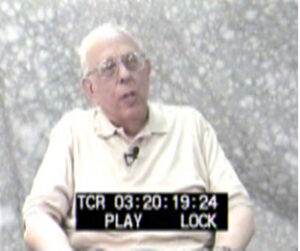The History of InfoAge Science & History Museums
Oral Histories - Oral History LOUIS KAPLAN Interviewee: Louis Leo Kaplan
Interviewee: Louis Leo Kaplan
Interviewer: Michael Ruane
Date: 1998?
Place: Camp Evans – 9039
Media: NTSC Video
Summary: Mr. Irv Bauman
TAPE 5A LOUIS KAPLAN, PHYSICIST
Lou began by pointing out that all Evans employees worked under high security. He started working for $2000/yr; one of his grandchildren now earns $62,000/yr. A Bendix employee offered Lou a job with a Newark company, manufacturing light bulbs, where he worked until he received a security clearance from Ft. Monmouth and was offered a job there at the Evan’s Area. Then Lou was ordered to report to the Communications lab, where a Colonel informed him of job termination as a result of Senator McCarthy’s purge of Monmouth radical employees Management personnel cooperated with him as best they could by appearing as character witnesses. Many of his friends avoided Lou and his wife. He was welcomed by most professional persons with whom he related to include his Obstetrician and a Rabbi in Asbury Park who agreed to provide Hebrew School instruction for his first child. His brother-in-law had read in the New York papers about Lou’s indictment but sided with him. During the McCarthy Hearings, his lawyer and deputy sat with Lou on his behalf. Some people avoided him like a plague; others never held anything against him. His security clearance was removed, so Lou couldn’t work. Reasons for all this were not revealed to him. He indicated that at least 20 of the most brilliant engineers were targeted. As an example, one, a Radar Specialist, published a paper on “How to Beat the Stock Market”, one reason for termination. He called to tell this to his father. He was ultimately cleared, returned to work at Ft. Huachuqua, Ariz. as Chief of Radar. When cleared, Lou returned to become Deputy Director of a Shock & Vibration Group.
In support of a weather balloon, a very heavy tube was used to inflate the balloon. RCA, a contractor, developed a tube wrap-around circuit resulting in a smaller & lighter system needing l watt of power to produce 60 times more power. After a series of gyrating prices for the new tube, production cost finally reached $10 each, after Lou in 1950 gave RCA a statement that the tube would be in use for several years. The balloon was used to sense temperature, humidity, and pressure data and was tracked by Radar. A comparable component, a transistor would run $60 vs. $10 for the tube. Lou was proud of this work. Lou then described how well RCA treated his supervisor and his subordinates in a Newark, NJ athletic club with limousine transportation to and fro.
Lou identified George Rose, a scientist at Harrison Corp, whose crew built the first sub-miniaturized tube and the first Cathode Ray Tube. Lou had suggested 3 ideas relating to this work and George already had these in his “Little Box” Lou was in contact with Princeton regarding finding noise source and receiver calibration. He met and communicated with top management personnel there and at Harrison. Lou stated that he became an expert on noise detection and receivers.
Lou also met Bell Labs’ top manager who also was most cordial. Lou mentored a Berkley Professor in Nuclear Medicine and the X-Ray Section of a Cincinnati Hospital. The designation “Siberia” was applied to an area under the Evans’ Diana Ant-enna where Lou worked for 2 yrs, signing off on work brought out to him. Lou continued mentoring in the Hexagon and Evans. A Lt., assigned from RCA to Lou spent 2 yrs with him growing in technical know-how. Lou was very involved with shock & Vibration devices, which were very useful for equipment qualification. Iona College approached Lou for a loan of some of that equipment.
30 min.
5B A sound film on work done after 1995 in the Hexagon, detailing an enhanced information and technology program followed. It began by introducing the following work personnel: Tom Dellay – Communication Directorate Dorothy Brundridge – Battle Planning & Visualization Systems Mike Wedell – Voice Control Gary Blum – Space Technology Branch This documentary was repeated many times over a 90 minute period to complete the video.
Page created August 2, 2002
We Need Your Help! Volunteer with Us.
Join our mission to preserve historic Camp Evans and teach the public about science and history.
Sign up to join our team of volunteers and start on your own mission today.
InfoAge Science & History Museums
2201 Marconi Road
Wall, NJ 07719
Tel: 732-280-3000
info@infoage.org
webmaster@infoage.org
